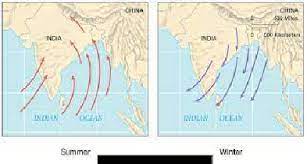Periodic winds are global wind patterns that result from the uneven heating of the Earth’s surface by the sun. These winds are an essential component of the Earth’s climate and play a significant role in the distribution of heat and moisture around the planet. In this article, we’ll explore the different types of periodic winds, how they work, and their impact on our planet.

Table of Contents
What are Periodic Winds?
Periodic winds are large-scale wind patterns that occur globally and are driven by the uneven heating of the Earth’s surface. It’s direction changes with change in season. Monsoon is one of the types of Periodic Wind.
Monsoon winds
Conclusion
In conclusion, periodic winds are a crucial part of the Earth’s climate and play a significant role in regulating the planet’s temperature and weather patterns. Understanding how these winds work and their impact on our planet is essential to addressing global climate change, ensuring food security, and promoting sustainable development.
Important Links